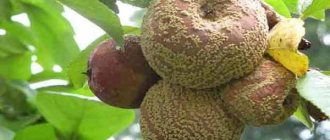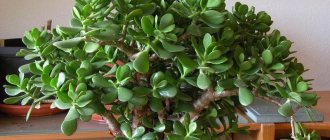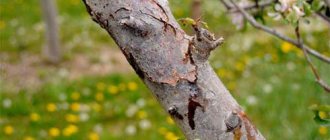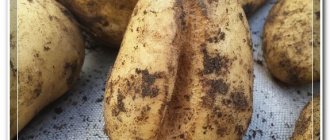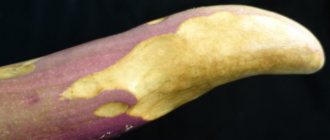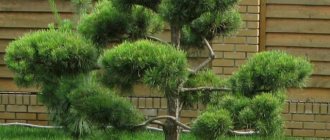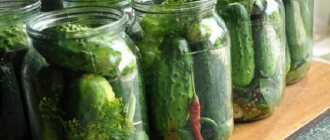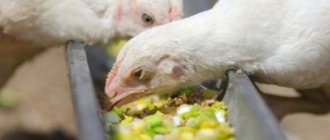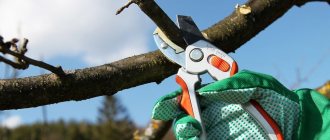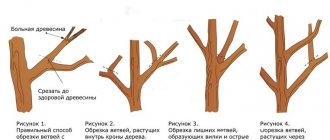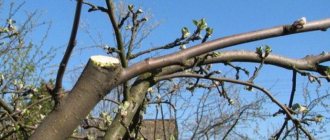Why prune an apricot?
Proper pruning of an apricot tree is an important process in its care. But not all gardeners know why to do this. The main reasons for pruning a plant are the following:
- Formation of a neat and beautiful crown. If it is not specifically pruned, the branches thicken and grow.
- Increased yield. Thickened branches inside the crown become bald, and fruiting decreases. Branches age faster, break and fall.
- Regulating the amount of fruiting in the first years of plant growth. Otherwise, the branches will break under the weight.
- Sanitary ventilation and treatment. Old and damaged shoots harbor pests and fungi. As a result, the apricot tree gets sick, productivity decreases and may even die. Plus, fungal and viral diseases spread more easily in a thickened crown.
Correct formation helps to obtain a beautiful, even crown. The apricot grows and develops healthy and bears fruit longer. It is possible to obtain a rich and healthy harvest. The fruits are large, sugary, juicy and warmed by the sun from all sides.
Common mistakes and their consequences
When pruning apricots, novice gardeners often make the following mistakes:
- using dull scissors, knives and saws. All this leads to the appearance of hangnails and unnecessary injuries to the branches;
- pruning outside the prescribed time limits. As a result, immunity is impaired and the tree is exposed to diseases;
- shortening of skeletal branches not along the ring;
- removing shoots in such a way that the upper shoots become longer than the lower ones;
- the upper tier is formed too high, which complicates the collection of apricots.
The main problem is the emergence of viral, bacterial and fungal diseases. Through fresh cuts, the pathogen can spread to other tissues of the tree, which will lead to a sharp decrease in fertility. Therefore, immediately after removing the shoots, water-based paint is applied to the cut site, and the area is also treated with antiseptics.
Find out, we previously wrote: why prune juniper in the fall.
When to prune an apricot, in spring or autumn and timing
Cutting apricot shoots is an event that is carried out in a complex. It is carried out in almost all seasons. It all depends on the purpose of the procedure. The most suitable time is spring and autumn, before and after the start of sap flow. At this time, the plant does not spend much energy on restoration and healing of wounds.
In the spring, shoots are cut off when the snow begins to melt. But the first leaves should not begin to appear yet. In most regions this is the beginning or middle of April.
And in the fall, after the leaves fall, when the movement of sap stops, but before frost, 2-3 weeks. This is necessary for the plant to adapt to winter. The ideal time for autumn pruning of apricot is mid-October.
Choosing tools for working with apricots
To shape the crown and shorten the shoots, you need to stock up on equipment. You need to purchase pruning shears, a grafting knife, a garden saw, and a file. You definitely need to have a whetstone on hand, which you have to use to sharpen tools quite often. Apricot wood is tough and strong, so the equipment quickly becomes dull. The pruning shears are adjusted using a nut that can be tightened and released.
Before cutting, the teeth of the saw are spread apart so that the sharp side points them inward. Before starting work, the tool is disinfected with an antiseptic so that germs from the diseased branch do not get onto the healthy plant. Rust on the saw and knife is smeared with garden paste, which is cleaned off with a sharpening stone before work.
Types of pruning and timing
There are three types of apricot shoot removal:
- formative,
- sanitary,
- rejuvenating.
Each procedure has its own appropriate time.
In the spring, formative pruning is carried out. This improves the quality of the fruit. The tree is not overloaded with apricots, as a result of which they do not become smaller.
In the fall, it is more convenient to carry out sanitary pruning of apricots. At this time, you can see which branches are damaged, sick and old. Thus, prepare the apricot for wintering.
Summer pruning is carried out if apricot trees need to be rejuvenated . At this time, most young shoots appear. It is optimal to do it once every three years.
Goals and objectives of pruning
Apricots are pruned to achieve the following goals:
- Rejuvenate the tree. This removal allows the crown to be formed. It is held in autumn or spring.
- Getting a rich harvest. By selective pruning, apricot fruit production can be increased on a permanent basis.
- Prevention of crown thickening. Too thick a crown is harmful to the tree and its productivity, so it is necessary to carry out pruning in a timely manner.
If you neglect pruning, fruiting will be high for several more years. But then it will begin to gradually fall. The crown will begin to grow, and because of its density, the internal branches will receive little light, which is why they will begin to wither and die.
As a result of crown thickening, unpleasant consequences arise for the gardener:
- fruits decrease in size;
- quality indicators decrease: sugar, juice, nutrients content;
- the harvest becomes irregular with breaks of 1-3 years or more.
Even if the yield does not fall, nothing good will come of it. The branched branches are flexible and fragile, overloaded with fruits, they break under their weight. As a result, productivity decreases.
Types of apricot crown and its formation
Forming a crown is required not only for the aesthetics of the garden, so that the plants look beautiful, but also for the health of the apricot and high yield. This helps to leave only healthy branches, to maintain the space between them to ventilate and prevent pests.
Sparsely tiered form
This shape is suitable for medium and short apricots. Form the crown from five main skeletal branches. Start pruning in the first year.
First, leave the lower branches 60-70 cm long. Form the next tiers with a distance of 45-55 cm. The topmost branch is located at a height of 1.7-2 m.
Place semi-skeletal branches in groups at intervals of up to 50 cm. To obtain a flatter shape, form skeletal branches at an acute angle.
As a result of this formation of the apricot crown, it can be placed compactly in the garden and is easier to harvest. The plant will not grow higher than 3 m.
Cupped crown
With this crown shape, the branches seem to emerge from one point. The advantage of this crown shape is that there is good ventilation and light inside.
Begin shaping immediately after planting. Take 3-4 strong and symmetrical branches, cut off the rest, including the central conductor. Shorten the skeletal shoots: top by 15 cm, middle by 25 cm and bottom by 35 cm.
Cut all branches to only one bud so that the crown develops to the sides. The distance from the ground surface to the first branch should be less than 1 m.
In the spring, prune immediately. Remove all young shoots and competitive branches. Change the direction of growth of a skeletal branch if necessary by trimming the top to a branch that grows in the desired direction. So, you can form all the shoots.
In the second year, form branches of the second order. On the main ones, select a pair of secondary ones and shorten them so that they grow in the same direction as the skeletal ones. All shoots growing inside the crown are removed. The distance between shoots of the 1st and 2nd order and between them should remain up to 30-40 cm.
In the third year, form shoots of the third order. Remove all unnecessary branches and those growing in the wrong direction.
Fruiting begins in the 6th year of growth; for this, carry out special pruning. Remove ⅓ of the branch length. Cut all old branches to developed and strong shoots.
Transferring a branch to a side shoot
Transferring a branch to a lateral young shoot is necessary in the following cases:
- change the direction and shape of the crown;
- weaken the branch;
- subordinate to the conductor;
- make the growing parts fruit-bearing.
To do this, shorten the desired branch by half its length. Next year, the upper bud will produce a continuation shoot, and the lower buds will produce lateral shoots. Cut off the first shoot, which goes as a continuation, as well as all the side shoots except one, the direction of which suits you. In the third year, cut off strong side shoots and slightly shorten adjacent weak ones.
Why is apricot pruned?
The need to prune apricot trees is caused by several reasons:
- The need for good lighting. The thickening of the apricot crown leads to a reduction in the formation of flower buds and drying out of the branches.
- The need for either rationing or stimulating the harvest. In an apricot, almost the entire ovary bears fruit, which naturally leads to overloading of the tree - breaking off branches, reducing the growth of new shoots and the formation of a fruitful ovary, and reducing productivity. On the other hand, without pruning, the branches quickly become bald, fruiting is transferred to the periphery and becomes scarce.
Let's take a closer look at each of the points.
Yield rationing
Fruit laying on apricot trees occurs on bouquet branches and spurs that grow mainly on the shoots of the previous year.
Accordingly, to obtain a good apricot harvest, it is necessary to ensure a strong growth of young shoots. To do this, adhere to the following algorithm:
- 1-2 lateral branches are shortened, leaving 5 centimeter branches for strongly branching varieties or 15 centimeter branches for weakly branching apricots. During the growing season, 3-4 strong shoots and several weak ones are formed on such knots;
- next year, the most powerful shoot is shortened, cutting off to 10 cm, and the rest - by 1/3 of their length. During the growing season, twigs with flower buds are formed on them, and long shoots are formed on the twig;
- the next year, the most powerful of these shoots is again shortened by a branch, and the rest by 1/3 of the length. The fruit branches formed in the previous year are harvested;
- short branches that bear fruit are cut to the bottom branch or into a ring, and dead spurs are removed.
Crown thinning
If you do not prune, the young tree actively forms a crown in the first years and produces good yields, but then, 4-5 years after planting, the situation changes radically. As the crown grows, becomes bald in the middle and thickens at the periphery, fewer ovaries are formed, and the marketable quality of the fruit deteriorates. Carrying out preventive pruning allows you to:
- increase light and air permeability of the crown;
- stimulate the growth of shoots and the formation of flower buds;
- adjust the number of fruits on the branches;
- reduce the likelihood of tree damage by pests and diseases;
- extend the life and fruiting life of apricots;
- simplify harvesting.
Depending on the purpose of preventive pruning, timing and specifics of implementation, pruning is divided into several types.
- Formative - allows you to get a powerful and at the same time well-lit crown. In addition, it is used to stimulate the growth of branches. This type of pruning is carried out on young trees, before they enter the fruiting period.
- Sanitary – carried out in the spring-summer-autumn season with the aim of cleaning the tree from dried, diseased or frozen branches.
- Regulating – carried out on mature, already fruit-bearing trees. Its goal is to maintain an optimal ratio between leafy and fruiting branches.
- Rejuvenating - practiced for old apricot trees, because with age, the growth rate of shoots decreases from 0.8 - 1 meter to 20 centimeters. Thinning is carried out in early spring or early summer, by removing 1-2 large branches inside the crown, shoots on the trunk, and side shoots on the lower tiers.
Regulatory tree pruning
This type of pruning is applied to the entire tree as opposed to detail or rejuvenation pruning. Its purpose is to increase illumination and ventilation in the middle of the crown. Remove all branches growing crookedly, branches in the wrong direction, tangled branches, as well as dry, large and damaged branches.
Do not touch the conductors unless it is necessary to stimulate shoot growth.
Trim skeletal branches and main branches of the second order, leaving a distance between them of up to 50 cm. The same applies to the remaining branches. Separate fruit shoots at a distance of 30 cm.
If after pruning the number of fruits increases, then carry out radical pruning. Remove flower buds and encourage new growth. Leave only 2-4 buds.
Regulatory pruning of an adult tree from the age of 5 years
Most apricots begin to bear fruit at the age of 4–5 years. From the 6th year, regulatory pruning is carried out, this has a positive effect on the yield.
- At the ends of the branches of the first and second order, 2–3 annual shoots are left for fruiting, shortening them by a third.
- Between them there should be a replacement knot - the most developed shoot shortened to 10 cm.
- On branches older than 4 years, fruit-bearing branches are cut to a second-order or skeletal shoot, and these, in turn, are pruned into 6–8 buds.
This pruning is carried out annually until the tree requires rejuvenation.
Anti-aging pruning
Rejuvenation pruning is a great way to give a tree longevity. There is no need to be afraid to carry it out. You extend the fruiting period. But it should not be carried out when shoot growth is less than 10 cm per season.
To avoid losing yield, do anti-aging pruning in early spring or late autumn after harvesting the fruits.
If the tree is not too neglected and overgrown, then you can get by simply leveling the crown. To do this, trim off all old, dry, damaged and diseased branches. For rejuvenation, at this stage it will be enough.
Sanitary and rejuvenating pruning and crown formation of apricot
For old trees, do radical pruning. This will allow the formation of a new crown for a couple of years to come. However, be careful and don’t cut everything off at the root. Otherwise, the tree will stop bearing fruit and begin to dry out. Leave a couple of flower and leaf buds.
How to shape an apricot tree
In practice, several options for forming the apricot crown are used:
- bush form, which is characterized by the absence of a central conductor and a single-tier arrangement of several branches of equal strength;
- a sparsely tiered crown formed by several levels of skeletal branches.
Each option has its own advantages.
Bush shaped
The bush-shaped forming principle is suitable for low-growing varieties of apricots, as well as for trees cultivated in cold regions. It allows:
- get low, lush plants with a large number of bouquet branches and spurs;
- constant renewal of branches, ensuring an annual harvest;
- resistance to freezing due to the “grounded” arrangement of the branches and the ability to completely cover the tree for the winter if necessary;
- self-shading, protecting branches and fruits from sunburn;
- minimal risk of damage to apricot branches by strong gusts of wind;
The formation of an apricot bush is carried out on one-year-old seedlings in the spring - before the buds open. To do this, they are cut at a height of 30-40 cm, which leads to the awakening of dormant buds and the growth of side shoots. Actively growing branches form a small bush by autumn.
The next pruning is performed in the 2nd year - the overgrown apricot branches are shortened by 1/3 of the height. In the 3rd year, 6-8 main fruit-bearing branches are formed from them, while shoots growing inward or horizontally are removed. In 3-4 years, the apricot turns into a bush 2.5-3 meters high. The process of creating a bush by year is covered in great detail in the following video:
Sparsely tiered crown
A sparsely layered crown is more suitable for apricot trees grown in regions with a mild climate. It allows you to achieve uniform ripening of fruits, providing lighting and ventilation of the crown, and simplifies harvesting.
The crown is formed over four years according to the following scheme.
- For annual seedlings planted in spring, the central conductor is cut short, leaving 3-4 buds on it.
- In the second year, 2-3 future skeletal branches are left, extending from the trunk at an angle of 45 to 80 degrees, located at a height of 10-20 cm from each other, located along the circumference of the trunk (i.e. they should look in different directions). They are cut to half their length, all other shoots are removed into a ring. The central conductor is cut at a height of about 25 cm from the base of the upper skeletal branch.
- In the third year, a second-order tier is formed from 1-3 branches located at a distance of 60-80 cm from the nearest skeletal branch. All shoots that grew over the past season are shortened by half if they are more than 70 cm, and by a third if they are less than 70 cm. The guide is left about 50 cm long from the base of the upper skeletal branch.
- In the fourth year, the formation of a sparsely tiered crown ends - another 1-3 branches of a new tier are left, and the central conductor is removed above the uppermost skeletal branch. On the second tier, shoots of the second order are laid, and on the first - the third.
In addition, a detailed video on the formation of a sparsely layered crown:
Sanitary pruning
Sanitary pruning is necessary to remove diseased and damaged branches and twigs so that they do not further spread the infection. During it, old branches are cut off so that they do not fall and injure someone.
Sanitary pruning is seasonal. The right time is vegetative dormancy before and after wintering. At this time, it is easier for the tree to endure such a procedure. In different regions, this period depends on climatic and weather conditions. The average daily temperature should not be below 8 degrees. The period of such pruning begins at the end of October and lasts until early spring.
When sanitary pruning, remove:
- dry and withering branches;
- diseased shoots and infested with pests;
- stumps from a previous unsuccessful pruning or branch break;
- broken or slightly damaged branches;
- dry branches that have grown into living wood;
- tangled, improperly growing shoots;
- damaged by rodents.
The rules for sanitary pruning are as follows:
- Cut only from the healthy side;
- Leave smooth cuts;
- If the branches are large, make the cuts convex;
- Lubricate the cut areas with garden varnish or drying oil paint. Read the article: How to use garden pitch correctly and what can be used instead.
Carry out the procedure as if it were a surgical procedure: wearing gloves and clean instruments. Make sure that the branches do not crack and the bark is not damaged. Cut down large branches in several stages, cutting in parts. But cut off small branches completely, do not leave stumps, as they do not heal well.
When pruning broken but healthy branches, do them on the side. We wrote about such pruning a little higher.
Varieties of forms
Young shoots on fruit trees bear fruit abundantly for 3 years. In spring, a mass of ovaries appear on them, but after a short period the yield decreases, but new branches grow to replace them. Experienced gardeners know how to give apricots a decorative appearance. The cypress form helps the owner of a small plot to save space for planting other crops. The crown of the tree is compact and not spreading.
Apricot, which is formed in the form of a palmette, grows as a bush and looks very beautiful; picking the fruits from it is a pleasure. This pruning scheme is quite complicated; not every gardener will be able to master the process.
The easiest way is to give the tree the appearance of a ball. The shoots are shortened in the third year after planting.
For tall apricots, the sparse-tiered form is more suitable, because it prevents growth. In regions where winters are cold and there is a lot of snow, the shale form predominates. Low trees make them look like a bowl:
- 4 years after planting, 3 strong branches are selected from the apricot, the rest are shortened to stumps.
- Subsequently, the shoots are equalized so that they have the same length.
- On skeletal-type branches, 2 more smaller ones are formed, leaving no more than half a meter between them.
Regulatory pruning is done to remove suckers that grow inside the trunk. The procedure helps improve lighting.
Pruning and shaping the apricot crown depending on the season
Depending on the time of year, each type of pruning has its own nuances. Carry out the desired type of procedure at your time. This will help improve the result.
Apricot pruning in spring
Many gardeners believe that pruning can be done in the spring at any time. But that's not true. The best time is before the sap begins to flow, just before the tree awakens. The temperature should be no lower than 5-7 degrees. Wounds must be covered with varnish or drying oil paint.
In the middle zone, such conditions are established in late March and early April.
Summer pruning of apricot
This is the most difficult procedure, since the tree is in the active growing season. In the summer, seedlings that have not yet begun to bear fruit are formed. Pruning involves shaping the crown, cutting off weak shoots and branching branches.
In ripe apricots, shoots affected by pests and diseases are removed. If this is not done immediately, the infection will spread and may destroy the crop.
Apricot pruning in autumn
In the fall, sanitary and formative pruning is carried out. However, it must be done in advance, long before the onset of frost. The average daily temperature should not fall below 8-9 degrees. If you do this too late, the apricot may not survive the removal of the branches well; the wounds will not have time to heal.
Autumn pruning is carried out only for mature plants. Young apricot seedlings may not have time to grow stronger before winter and may die during severe frosts.
Apricot pruning by season
Apricots can be pruned at any time of the year. But you need to remember some differences for each case.
in spring
The optimal spring time in central Russia is the end of March.
Pruning is carried out under several conditions:
- temperature above - 5 °C;
- the sap does not come out from the tree or comes out poorly.
In the spring, the following activities are performed:
- carry out crown formation;
- carry out sanitary and preventive measures;
- cut off old, frozen, burst, broken branches.
If you follow these rules and methods, you can get delicious apricots.
In summer
Anti-aging pruning needs to be done by mid-July. From May 15, the sprouts that have grown this year are pinched to 20-25 cm. You cannot perform summer pruning every year; you need to take breaks of 2-3 years. Mostly in the summer, newly emerged shoots are removed to rejuvenate the tree. But at the same time you need to leave 20-30 cm of their length. If new shoots appear after pruning, they need to be removed, leaving 3-4 pieces.
in autumn
In the Moscow region, it is advisable to prune at the end of October or the beginning of the next month after the foliage has completely fallen. In autumn, cut off all unhealthy branches. This is necessary so that during frosts the infection does not spread to the rest of the tree. You can also shorten all shoots by 30%, but do not touch the skeletal branches.
in winter
This is the ideal time for pruning, since the removal will take place before the juices begin to move through the tissues, which means it will be painless. During this period, the crown is formed. An important condition is the temperature - it should be no lower than - 8 ° C, since during severe frosts the branches become fragile and regeneration slows down greatly.
It is recommended to do the main pruning in winter for several reasons:
- the view is not blocked by dense foliage, the crown is clearly visible;
- the plant receives less harm due to the slow movement of sap;
- cold branches are easier to saw and cracks do not form.
Rules for caring for a tree after pruning
Proper care of apricots after pruning will improve the results of the procedure next year. Be sure to:
- fertilizing In April, apply rotted manure or compost under each tree. Chicken manure will also work. Feed the apricot a second time in the summer with the same fertilizers. Phosphorous, enhance flowering and fruiting. In the fall, add potash, which increases winter hardiness.
- Organize regular watering. Apricots need frequent watering in hot and dry weather.
- Keep an eye on the cuts and, if necessary, lubricate them with varnish and a solution of potassium permanganate.
Necessary care after cutting branches
When forming the crown and shortening the shoots, the tree must be carefully looked after. Having completed the procedure, proceed to other important work:
- The cut areas are covered with garden varnish with a layer of at least 0.5 cm.
- Extensive wounds are disinfected with copper sulfate.
- In order for the apricot to take root faster, fertilizers containing phosphorus and nitrogen are applied to the tree trunk.
If the cuttings are not treated, microbes appear and the plant gets sick. You can make your own putty from fir resin. In a metal bowl, 100 g of this substance is mixed with 10 grams of wax and heated until the mass melts. When it cools down, pour in a spoonful of warm alcohol.
Var, which quickly hardens and seals cuts well, can be prepared from other components. Over low heat you need to melt 400 g of rosin, 200 beeswax and 110 fat. When the mixture is heated, pour a glass of linseed oil, mix and place in cold water.
When to prune in summer according to the lunar calendar
Pruning an apple tree in summer and how to do it correctly
Experienced gardeners recommend familiarizing yourself with the lunar calendar before shaping an apricot. It's no secret that for many years it has been used by all summer residents to determine the best periods for planting, harvesting or even weeding their garden plot. All favorable or unfavorable days are clearly stated in the lunar calendar. For example, pruning in July should be carried out exclusively during the period when the moon is waxing. In this case, the procedure will bring maximum benefit not only to the tree itself, but will also have a positive effect on apricot yield.
Important! Rejuvenating old apricots by pruning is very important, since removing old branches promotes better development of new shoots and prolongs the fruiting period of the tree.
Types of pruning of apricot trees in autumn and spring
The peculiarity of the apricot is that it grows quite quickly and lays down many generative buds. Strong branching of the crown and overload of fruits cause various tree diseases, drying of branches and deterioration of their fruiting function, therefore it is recommended to prune apricots 3 times a year: in spring, summer and autumn . At the same time, autumn pruning is necessary only for early and mid-ripening varieties.
In each period, depending on the goals, a different type of pruning is performed:
- formative;
- regulatory;
- rejuvenating;
- restorative;
- sanitary
In the autumn, as a rule, formative, regulating and rejuvenating pruning is carried out.
Formative pruning is carried out on young trees. It allows you to give the crown a certain shape, and also stimulates the growth of branches for a quick start to fruiting.
By leaving the natural shape of the crown, you will not be able to get a bountiful harvest of fruits every year. Over time, apricots become smaller and lose their presentation and taste.
Apricot trees with a natural crown begin to bear fruit early, but are quickly depleted
Heavy formative pruning should be stopped for 2–3 years during the transition period of the tree’s life (before fruiting begins). At this time, only thickening and inward growing branches need to be shortened to lighten the tree.
Regulatory pruning is carried out after the plant begins to bear fruit . Its main task is to maintain a physiological balance between yield and shoot growth.
Mature apricot trees that show weak shoot growth (length up to 20 cm) need rejuvenating pruning . Pruning enhances the growth of old branches and stimulates the appearance of new ones. In addition, after the procedure, the plant becomes strong and resistant to temperature changes.
If there are diseases and pests in the fall, sanitary pruning of apricots is also carried out . Its essence is to remove damaged or diseased branches, followed by the use of special drugs for the disease.
Autumn pruning is a great way to prepare apricots for a cold winter and increase their yield for next year. It is better to produce all types of autumn pruning in a comprehensive manner, combining them with each other.
If the tree winters safely, it will not need restoration pruning in the spring, which is also important for gardeners who value their time.
The task of autumn pruning of fruit trees is to prepare them for wintering and increase productivity for the next year
Types of tree pruning in the summer season and timing
In the summer, three types of apricot pruning are performed:
- sanitary cleaning,
- June recovery after fruiting,
- rejuvenation of old trees in August.
Throughout the summer, as in any other season, the tree is sanitarily cleaned of dry, damaged, and diseased branches.
In the summer, gardening experts recommend restorative pruning for fast-growing trees. It increases the winter hardiness of flower buds. According to what scheme should it be carried out?
- Strong stems that have recently come into force should be shortened to 30 cm.
- Less - by a quarter - cut off the weaker shoots. The tree's strength will not be wasted; many new branches will soon form.
- Leave about three of the strongest shoots, which are sure to become fruitful.
This type of pruning is done in early June. Early summer pruning creates conditions for strong growth. Until autumn, the plant restores the volume of foliage and lays buds for the future harvest. The fruiting of the tree increases. The size of leaves and fruits increases, the incidence decreases. The results will be visible within a year and will remain unchanged for another three years. Therefore, more often than after 3 years, early pruning of apricot trees in summer is not recommended.
On the issue of crown formation in an abandoned tree
The fact is that the old crown cannot be put in order at once. This is a matter of several years. Only if all conditions are met will beautiful vertical shoots appear again.
Typically, pruning is spread over two or three years. When you first prune, remove most of the extraneous branches. Also, high crowns are transferred to the lower tiers. This will make it easier to care for the plant and harvest the fruit.
For this type of pruning, it is better not to use pruning shears. This is where a garden bow saw comes in handy. Immediately treat wounds formed after pruning with garden varnish. Indeed, in this case, pests and fungal diseases will not be able to sneak into the wood.
Why does apricot need pruning?
Fruit tree pruning is carried out for the following purposes:
- Crown formation. The natural growth of branches forms an excessively thick “cap” on the apricot. The tree bears fruit abundantly, increasing the load on the crown, but is depleted in a short time. Many shoots reduce light and air access to the crown, which leads to a decrease in size and deterioration in the taste of the fruit.
- Sanitary pruning. It consists of removing dry, diseased and damaged branches, in the wood of which conditions suitable for the proliferation of pests and diseases are created. The tree also expends energy on their support and restoration. This reduces the yield and quality of the fruit.
- Rejuvenation. Over time, old branches are replaced by young shoots, which maintains the viability of the plant and preserves the yield and quality of the fruit.
Trimming scheme
Restorative pruning (chasing), which promotes the rejuvenation of trees and a good harvest, is carried out once every three years. Its main goal is to obtain a large number of young, healthy shoots.
It is advisable to subject dynamically growing apricots that produce a growth of at least 40 cm to it.
Restorative pruning (its scheme is unusually simple) is carried out in two stages:
- At the first stage, the shoots of the first year of life are pruned, leaving no more than 30 cm of the original length. This manipulation allows the tree not to waste extra energy on providing nutrition to extra branches.
- After two to three weeks, many young shoots of the second wave will appear on the tree. Having chosen the three (no more) strongest ones, cut out all the rest. It is on these branches that generative buds will form in large numbers and the fruits of the future harvest will set. From them the second tier of skeletal branches can be formed.
The consequence of such pruning will be a significant increase in yield, which will begin only in the next season and will last over the next 3-4 years. The wounds left at the site of the cuts will heal completely before the onset of autumn, and the tree will have time to properly recover and prepare for winter.
During anti-aging pruning, in addition to excess young growth, you can remove:
- woody shoots;
- part of the old branches (doing this gradually and very carefully so as not to provoke the death of the tree).
How to properly prune apricot branches in autumn
In autumn, it is recommended to prune early or mid-ripening trees. Also in the autumn, it is advisable to rejuvenate the crop - remove old, dried branches and wood. The rejuvenating process allows you to get good growth and shoots even on a perennial plant.
In addition, the tree becomes resistant to temperature changes and various diseases. Only in this case will the apricots grow large and sweet. At this time of year, to form the crown, it is advisable to resort to a tiered pruning scheme of four or six skeletal branches.
Remove old branches by approximately one-third of the total length. Don't forget to cover the wounds with garden varnish. If weather forecasters predict a rainy and cold autumn, then it is better to refrain from this procedure. After all, these weather conditions will weaken the culture. In the southern regions, on the contrary, it is recommended to prune with the onset of autumn.

